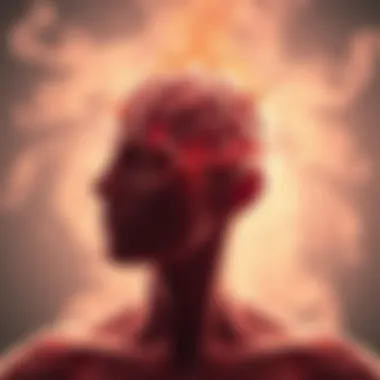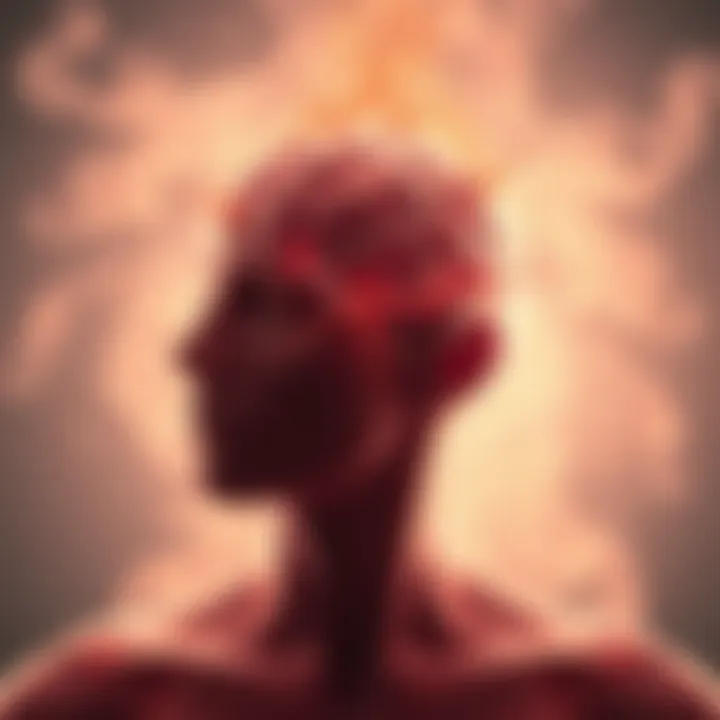Anxiety's Role in Inducing Fever: A Closer Look


Intro
The connection between anxiety and fever is an often-overlooked topic, yet it carries profound importance in understanding one’s health. When one experiences anxiety, the body’s reaction is more than just mental—it can ripple through various physiological systems, sometimes leading to physical symptoms like fever. This relationship is not merely a product of conjecture; it is supported by a growing body of research in the fields of psychology and medicine. As we set out to explore this intricate link, it's paramount to delve into the underlying mechanisms that connect our mental and physical well-being.
Understanding Mental Health and Well-being
What is Mental Health?
Mental health encompasses our emotional, psychological, and social well-being. It affects how we think, feel, and act. Additionally, it plays a role in how we handle stress, relate to others, and make choices. Even the most composed-minded among us can face vulnerabilities that impact their mental health. Thus, grasping this broad spectrum is essential to understand any mental health challenge, including anxiety.
The Importance of Prioritizing Mental Well-being
Mental well-being acts as the foundation for overall health. Ignoring it can lead to a cascade of issues, both mentally and physically. Just as you would not neglect a toothache, it is vital to acknowledge when your emotional health is off kilter. Prioritizing mental health means not only addressing anxiety but also fostering a nurturing environment for your mind.
Common Mental Health Challenges and Disorders
Mental health challenges vary widely in nature and severity. Anxiety disorders, such as Generalized Anxiety Disorder, Social Anxiety Disorder, and Panic Disorder, are prevalent. The National Institute of Mental Health highlights that anxiety affects about 19% of adults in the U.S. annually. Individuals experiencing these disorders can often find themselves caught in a vicious cycle, where anxiety can lead to physical manifestations, one being fever—a physiological reaction our body produces under stress.
Strategies for Improving Mental Health
Self-care Techniques and Practices
Engaging in self-care is not just a buzzword; it’s a practical approach to enhance mental health. Practicing mindfulness can help manage anxious thoughts. Regular exercise releases endorphins, which work wonders in alleviating anxiety. Establishing healthy sleep patterns is another pillar of well-being, as sleep deprivation can intensify stress responses in the body.
Building Resilience and Stress Management
Resilience is key to navigating life’s challenges. Techniques such as cognitive restructuring help in viewing stressors from a different angle to lessen their emotional grip. Keeping a gratitude journal can also serve as a reminder of the positives in life, allowing one to cope better when anxiety strikes.
Seeking Professional Help: Therapy and Counseling
When self-help isn’t cutting it, professional intervention might be the way to go. Therapists can provide tools tailored to your needs, helping decipher the patterns of thought and behavior that contribute to anxiety. Cognitive Behavioral Therapy is one method that’s proven effective, especially when dealing with physical symptoms linked to anxiety.
Finding Balance in Life
Healthy Lifestyle Choices: Diet, Exercise, and Sleep
Diet is often overshadowed in discussions about mental health, yet it plays a substantial role. Fueling the body with nutritious food promotes optimal brain function and overall health. Consistent exercise and prioritizing sleep cannot be overstated; both are fundamental supports in managing anxiety.
Mindfulness and Meditation Practices
Incorporating mindfulness practices daily offers a grounding space in the whirlwind of life. Simple techniques like focused breathing or guided meditation can effectively reduce stress. Just as one protects the body from cold with a coat, mindfulness can shield the mind from overwhelming stress.
Setting Boundaries and Managing Time Effectively
Setting boundaries is crucial in maintaining mental health. By knowing when to say no or to take a break, you prevent overwhelm. Effective time management, including breaking tasks into manageable chunks, can also reduce anxiety and improve overall well-being.
Enhancing Personal Development
Goal Setting and Productivity Tips
Clear goal setting can drive motivation and reduce feelings of chaos. Goals should be SMART—specific, measurable, achievable, relevant, and time-bound. This approach adds a level of clarity and focus to tasks, fostering a sense of accomplishment that can counteract anxiety’s grip.
Building Healthy Relationships and Social Connections
Healthy social connections can act as a protective barrier against anxiety. Surrounding oneself with positive influences fosters an environment conducive to well-being. Reaching out for support is a strength, not a weakness.
Practicing Gratitude and Positivity
Incorporating gratitude into daily life helps shift focus from stressors to positives. Recognizing what you are thankful for can remind your mind of the good, counterbalancing anxious thoughts and promoting a more favorable outlook on life.
Tips for Maintaining Mental Well-being
Strategies for Preventing Burnout
Burnout can be a silent enemy. Recognizing the signs early—like fatigue, irritability, or disengagement—can prevent it from progressing. Regular breaks and ensuring a proper work-life balance go a long way in preventing burnout.
Coping with Challenges and Setbacks
Challenges are inherently part of the human experience. When faced with setbacks, practicing self-compassion is vital. No one has a perfect path, and it’s okay to stumble. Reflecting on past challenges and recognizing growth from them can foster resilience.
Creating a Supportive Environment
Building a supportive home or work environment revolves around open communication. Sharing struggles with trusted individuals creates a sense of connection. As you foster a culture of understanding, not only do you benefit individually, but so does your community.
Mental health issues are real and know no boundaries. Addressing these issues can lead to significant improvements in overall health, even reducing physical symptoms such as fever.


Understanding the connection between anxiety and fever is just part of a larger dialogue around mental health. Through persistent exploration and the development of strategies, individuals can take actionable steps toward enhancing their mental well-being and, in turn, their overall health.
For more resources on mental health and well-being, you may explore:
- The National Alliance on Mental Illness
- MentalHealth.gov
- American Psychological Association
- HelpGuide.org
- Mindful.org
Understanding how mental health can manifest physically allows us not just to address the symptoms but to also tackle the underlying causes, ushering in a more peaceful existence for those grappling with anxiety.
Understanding Anxiety
Anxiety, a term that seems to float around in everyday conversation, holds a depth that often goes unexamined. In the context of this article, understanding anxiety is crucial as it sets the stage for exploring its physical manifestations, like fever. The connection between mental and physical health has been a subject of vast interest, and dissecting anxiety allows us to better comprehend its implications in both clinical and everyday settings.
Definition of Anxiety Disorders
Anxiety disorders encompass a range of mental health conditions characterized by excessive fear or worry. The flavors of anxiety can be complex; Generalized Anxiety Disorder (GAD), Social Anxiety Disorder, and Panic Disorder each tell a distinct story of how these feelings can infiltrate daily life. In essence, anxiety disorders disrupt the natural flow of emotions, sometimes leading individuals into a spiral that can feel all-consuming.
"Anxiety disorders are not just fleeting feelings of worry. They are persistent and often debilitating issues that can affect every aspect of life."
Common Symptoms of Anxiety
Identifying anxiety isn't always straightforward, as symptoms can manifest differently from person to person. Common signs include:
- Constant restlessness or feeling on edge
- Increased heart rate
- Difficulty concentrating
- Shortness of breath
- Physical symptoms like sweating or trembling
Knowing these symptoms is key to recognizing anxiety not just as a fleeting state but as a condition that can affect your body at a systemic level. When the body's stress response is triggered frequently, it can lead to physical discomfort that might mimic illnesses, such as fever.
The Psychological Impact of Anxiety
The psychological toll of anxiety is profound. It’s like living in a shadow that never fully lifts. The constant worry can potentially lead not only to stress but also to issues like depression. Inabilities to cope with everyday stresses may cause individuals to cultivate negative thought patterns. Over time, these psychological impacts can contribute to a sense of isolation, compounding the effects of anxiety and leading to further physical symptoms, twisting the mind-body relationship into a complicated web.
In summary, the landscape of anxiety encompasses various disorders, symptoms, and psychological ramifications. Gaining a clear understanding of these elements is foundational for grasping how anxiety can reach beyond mental health occasions, eventually affecting physical states such as fever.
The Body's Response to Stress
Understanding how our bodies respond to stress is essential in unraveling the complex relationship between anxiety and physical health. When faced with stressors, whether they are psychological or environmental, the body reacts in a variety of ways that can affect both mental and physical well-being. This section will explore the physiological reactions to anxiety, the role of stress hormones, and the fight or flight response, all of which provide insights into how anxiety can potentially trigger physical symptoms like fever.
Physiological Reactions to Anxiety
Anxiety doesn’t just sit in the mind; it reverberates through the body like a drum during a parade. When a person experiences anxiety, a cascade of changes occurs within their physiology. Heart rate often spikes, muscles tense, and breathing can become shallow and rapid. These symptoms form part of a natural defense mechanism designed to prepare the body for perceived threats.
The sympathetic nervous system plays a crucial role here, acting like a switch that flips on when anxiety knocks at your door. When this system activates, chemicals like adrenaline flood the bloodstream, increasing energy and alertness while simultaneously diverting resources away from non-essential functions such as digestion. The result? Individuals might feel a surge of energy during anxiety, but this can lead to wear and tear over time if the stress response is triggered too frequently.
Stress Hormones and Their Effects
When it comes to stress responses, cortisol is a name that often pops up. Known as the body's primary stress hormone, cortisol serves a variety of functions, from regulating metabolism to controlling blood sugar levels. However, when one experiences chronic anxiety, cortisol levels can remain elevated. This constant state of heightened alertness is more than just a nuisance; it can disrupt bodily functions, leading to a myriad of physical health issues.
Some effects of prolonged exposure to high cortisol levels include:
- Vulnerability to infection due to a weakened immune response
- Increased blood pressure
- Weight gain, particularly around the abdomen
- Difficulty sleeping, leading to a cycle of fatigue and anxiety
Understanding this balance is critical. On one hand, cortisol helps the body respond to stress; on the other hand, when it overstays its welcome, it can wreak havoc. Moreover, this imbalance may create a pathway to various other complications, including potential fever-like symptoms induced by psychosomatic responses.
Fight or Flight Response
The term "fight or flight" is often thrown around casually, but its implications run deep. This biological response is our body's instinctual reaction to danger or stress. When an individual perceives a threat, their body prepares to either confront the danger or flee from it. In practical terms, this means an increase in heart rate and respiration as the body readies its muscles for action.
While the fight or flight response is part of our evolutionary anatomy, in modern life, it can be triggered by non-physical threats such as paying bills or meeting deadlines. The catch? While historical threats required immediate physical responses, today's anxiety often requires a more nuanced approach.
"The mind is its own place, and in itself can make a heaven of hell, a hell of heaven." — John Milton
In essence, the body doesn't know if the threat is a lion or an upcoming presentation. Both elicit similar responses, which can lead to the manifestation of physical symptoms, including elevated body temperature.
Recognizing these physiological responses provides valuable insights into how to manage anxiety effectively. Understanding that these processes are not merely psychological, but deeply rooted in our biology, lays the groundwork for better coping strategies and management techniques.
By dissecting how our bodies react to stress, we pave the way to grasping the intricate interplay between anxiety and fever. This knowledge is not just academic; it has real implications for how we understand and treat anxiety as part of a holistic approach to mental health.
Can Anxiety Cause Fever?
Exploring whether anxiety can trigger fever is crucial for understanding the intersection of mental and physical health. Many individuals grapple with the complexities of how emotions influence bodily functions, and this section goes right to the heart of that inquiry. Anxiety, often seen as a purely mental concern, can express itself in various physical symptoms. Recognizing this connection can empower individuals to seek appropriate interventions, ensuring both mental and somatic well-being.
Medical Perspectives on the Issue
From a medical standpoint, it's essential to sift through the layers of anxiety-related symptoms, particularly the potential for fever. While anxiety itself does not typically cause a significant increase in body temperature like an infection would, there are nuances to consider.
Some medical professionals argue that the body’s response to anxiety—particularly through the release of hormones like adrenaline—can lead to a spike in body temperature under certain conditions. This phenomenon is not as straightforward as one might imagine. It conjures the picture of an orchestra, where different sections (biological responses, emotional triggers, and environmental stressors) must harmonize to create a cohesive response.
Interestingly, conditions like panic attacks can elevate body temperature temporarily, making it critical for healthcare providers to evaluate if a person’s feverish feelings stem from fear or a true febrile state. Understanding these nuances helps in delivering precise diagnoses and treatments.


Understanding Psychosomatic Phenomena
When we delve into psychosomatic phenomena, we encounter the fascinating juncture where mind meets body. It becomes starkly clear that what we feel mentally can echo through our physical being. Anxiety can incite a myriad of bodily reactions, leading to discomforting sensations that may mimic fever. For instance, flushed skin and a racing heart could be mistaken for illness.
"Psychosomatic responses illustrate that our mind is a powerful player in regulating how our body reacts to stress."
Such interconnections elucidate why some may experience elevated body temperature when overwhelmed emotionally. Stress-induced inflammation can even occur, further clouding the symptoms. Distinguishing between true fever and anxious manifestations aids in navigating treatment protocols effectively.
Research Findings and Clinical Studies
Numerous studies have aimed to unravel the strands connecting anxiety and physical symptoms like fever. For example, a study published in the Journal of Psychosomatic Research indicates a correlation between heightened anxiety levels and variations in body temperature among participants. This study utilized comprehensive methodologies, blending self-reported anxiety scales with physiological measurements, marking a step towards understanding these intertwined states.
Additionally, researchers at the University of California examined diverse populations, noting that individuals with chronic anxiety disorders often report fluctuating body temperatures. This data highlights the need for a more profound exploration of how emotions can precipitate physiological changes.
Despite these findings, extending the conversation past anecdotal evidence compels the medical community to refine their approach to diagnosis. Comprehensive diagnostic practices will likely result in more effective treatment outcomes.
In closing, even though a direct cause-and-effect pathway between anxiety and fever is complex, the impact of mental health on physical well-being cannot be understated. As research continues evolving, our grasp of such relationships will only deepen, ultimately guiding individuals towards better self-care and professional assistance.
Differentiating Between Fever and Anxiety-Induced Symptoms
Recognizing the difference between fever and anxiety-induced symptoms is crucial for understanding one's health. Many individuals experiencing anxiety may misinterpret their body's responses as a sign of an illness, leading to unnecessary worry or even panic. Thus, grasping the nuances between these two types of symptoms can help in both management and treatment. By identifying the root cause of the symptoms, one can seek appropriate help without losing time.
Physiological vs Psychological Symptoms
To differentiate between fever and anxiety-induced symptoms, it’s essential to understand the underpinnings of each.
- Physiological Symptoms: Fever is a direct physiological response, usually caused by an infection, inflammation, or another medical condition. The body increases its temperature to combat pathogens, leading to signs such as:
- Elevated body temperature (generally above 100.4°F or 38°C)
- Chills or shivering
- Sweating
- Muscle aches
- Fatigue
On the flip side, anxiety brings a range of psychological symptoms that can manifest physically, including:
- Increased heart rate
- Shortness of breath
- Sweating, but not in response to an infection
- Trembling
- Gastrointestinal distress
While both fever and anxiety-induced symptoms can cause discomfort, the mechanisms behind them are starkly different. Anxiety can create the sensation of heat or flushing, which may resemble a fever, but without an actual elevation in body temperature.
Recognizing the Signs of Each Condition
It’s important to recognize distinct signs that may point to whether one is facing a fever or anxiety-induced symptoms. Here are some indicators:
- For Fever:
- For Anxiety-Induced Symptoms:
- The presence of an actual elevated body temperature, which can be measured with a thermometer.
- Accompanying symptoms like cold sweats and overall malaise specific to infections.
- If symptoms persist beyond a couple of days or worsen, it may indicate a developing illness that requires medical attention.
- Symptoms may spike with stress or anxiety triggers like public speaking, social situations, or even thoughts of stressful events.
- The symptoms tend to dissipate after the anxiety diminishes.
- No feverish feeling in the absence of a physical illness, though one may feel hot due to anxiety.
Both conditions can greatly affect quality of life, but distinguishing between them allows for targeted coping strategies or treatments. If there is ever uncertainty after assessing one's symptoms, a professional should be consulted. This ensures safety and lays the groundwork for better mental and physical health.
"Understanding your body and mind is the first step to managing anxiety and health."
Resources for further reading:
By honing the ability to discern between physiological and psychological symptoms, one can take proactive steps towards achieving better health and wellness.
Factors Influencing Individual Responses
Understanding the factors that influence individual responses to anxiety and fever is an essential component of this exploration. Everyone’s body reacts differently to stress, including how anxiety may result in physiological symptoms like fever. This lifelong battle isn't as straightforward as merely feeling uneasy; various elements shape this experience. Recognizing these influences can lead to better coping mechanisms and improve personal health outcomes.
Genetic Predispositions
Genetics play a significant role in how we handle anxiety and its effects. Some individuals are wired to be more sensitive to stressors, while others may possess a more resilient response. For instance, variations in genes linked to neurotransmitters, such as serotonin and dopamine, can determine how our bodies react to anxiety. This sensitivity might not only heighten feelings of nervousness but could also predispose one to physical symptoms like fever. Studies suggest that individuals with a family history of anxiety disorders may experience these connections more strongly.
- Genetic factors affecting anxiety include:
- Variability in neurotransmitter function
- Family history of mental health issues
- Hereditary patterns of temperament
Understanding this predisposition means recognizing that it's not just a personal failing; it's grounded in biology. The road to effective management of anxiety-oriented symptoms can begin with this realization, prompting an individual to seek tailored strategies that resonate with their specific genetic profile.
Environmental Triggers
The environment dramatically shapes how anxiety manifests in each person. Certain settings or experiences can provoke anxiety responses leading to symptoms including fever. Environmental triggers might be anything from stressful job situations to traumatic life events or even mundane factors, like inadequate sleep or unbalanced diets. The presence of these triggers can cause the body's stress response to go into overdrive, making it crucial to identify and mitigate these elements.
Consider the following environmental factors:


- Cultural Expectations: Societal pressures and expectations can contribute to stress. In high-pressure environments, anxiety may spike more frequently, triggering physical symptoms.
- Lifestyle Factors: Poor nutrition and a lack of exercise can increase anxiety levels, leading to physical responses like increased heart rate and elevated body temperature.
- Social Surroundings: Relationships and social dynamics have significant impacts. Toxic environments can foster anxiety while supportive relationships can lessen it.
Addressing environmental factors may reduce anxiety responses, highlighting the importance of cultivating healthier environments both personally and professionally.
Cognitive Appraisal and Perception
How we perceive stress is an integral part of how it affects our mental and physical health. Cognitive appraisal refers to the personal interpretation of a stressor, determining whether we view a situation as threatening or manageable. This perception strongly influences our physiological responses, including potential fever responses.
People often experience anxiety because of their appraisal of circumstances:
- Negative Interpretation: Viewing life's challenges as insurmountable can intensify anxiety, leading to heightened physical effects.
- Resilience: Conversely, a positive outlook or constructive interpretation can buffer against stress-related responses.
- Coping Mechanisms: Well-developed coping strategies can change the way one appraises stressors, altering their reaction to anxiety.
Understanding cognitive appraisal offers a pathway to reframe thoughts and perceptions, potentially reducing anxiety-related symptoms significantly.
In the context of anxiety and fever, recognizing your individual triggers—genetic, environmental, or cognitive—can lead to better self-management and, ultimately, a healthier life.
Ultimately, the interplay of these factors forms a complex web of individual responses. Tailoring coping strategies to fit one’s unique profile is crucial in combating anxiety's influence on overall health.
Coping Strategies for Managing Anxiety
Anxiety can often feel like a heavy weight on one's shoulders, impacting not only mental well-being but also physical health. As we explore the complex interplay between anxiety and the body’s response, it's vital to address effective coping strategies. Managing anxiety is not just about reducing symptoms; it’s about cultivating resilience and enhancing overall quality of life.
Implementing coping strategies can make a remarkable difference in how individuals navigate their anxiety. Here are key elements to consider:
- Empowerment: Learning to manage anxiety gives individuals a sense of control over their lives.
- Physical Health: Reducing anxiety can lead to better physical health, including fewer stress-related illnesses such as fever.
- Emotional Resilience: Practicing coping strategies fosters emotional tools to handle stressful situations in the future.
Overall, having a toolkit of coping strategies can lead to healthier responses to stress and anxiety.
Mindfulness and Relaxation Techniques
Mindfulness and relaxation techniques are essential in the fight against anxiety. These methods focus on bringing attention to the present moment, helping to quiet the internal chatter that often accompanies anxious thoughts. By incorporating practices like deep breathing, progressive muscle relaxation, and guided imagery, individuals can significantly reduce their anxiety levels.
- Deep Breathing: Engaging in deep breathing exercises reduces tension and promotes relaxation; inhale through the nose for a count of four, hold for seven, and exhale through the mouth for eight.
- Meditation: Simple mindfulness meditation, even for just a few minutes daily, has been shown to lower anxiety and promote calm.
By committing to mindfulness and relaxation, individuals often find that their anxiety becomes more manageable and their daily experiences more fulfilling.
Cognitive Behavioral Approaches
Cognitive Behavioral Therapy (CBT) offers a structured method for tackling anxiety. Instead of just addressing the symptoms, CBT delves into the underlying thoughts and behaviors that contribute to anxiety. It’s about reshaping negative thought patterns and beliefs.
- Identifying Distorted Thoughts: Recognizing unhelpful thinking patterns allows individuals to challenge their perspective; for instance, viewing a mistake at work as a failure rather than a learning opportunity.
- Behavioral Experiments: Engaging in small challenges helps individuals test the validity of their fears. If someone is afraid of crowds, gradually exposing themselves to social situations can enhance coping skills.
Thus, CBT equips individuals with powerful tools to alter how they respond to anxiety-inducing situations.
Seeking Professional Help
While self-help strategies can be beneficial, there are times when professional help is crucial. Therapy and counseling can provide deeper insights and support that may not be achievable through self-guided methods.
- Therapists and Psychologists: Trained professionals can offer a variety of techniques tailored to individual needs, bombarding personal challenges with applicable expertise.
- Medication When Necessary: For some, medication prescribed by a psychiatrist can help relieve symptoms by offering a biological component to treatment.
Seeking help is a sign of strength. It acknowledges that one cannot always go it alone and that support can make a meaningful difference in managing anxiety.
Finale: Understanding the Interplay of Mind and Body
The connection between anxiety and physical health is undeniably intricate. As we've explored throughout this article, anxiety can manifest in numerous ways, affecting both the mind and the body. Understanding this interplay is not just an academic exercise; it holds profound implications for how we approach mental health and wellness. The concept of holistic health is becoming increasingly essential in contemporary discussions surrounding well-being.
Holistic health emphasizes the importance of viewing the individual as a complex interplay of physical, emotional, and mental components rather than just a collection of symptoms or isolated issues. When we acknowledge the connection between mental states, such as anxiety, and physical symptoms like fever, we can begin to adopt a more comprehensive approach to treatment and prevention. Here’s why this matters:
- Integrated Treatment Approaches: Acknowledging that anxiety can influence physical health can move healthcare providers toward integrated treatment plans that address both mental and physical symptoms simultaneously. This avoids the pitfall of treating anxiety in isolation from its physical effects.
- Empowerment Through Knowledge: Individuals armed with understanding about how anxiety can affect their body, such as causing fever, can take proactive steps in monitoring their health. This can lead to more informed conversations with healthcare professionals and ultimately more tailored and effective care.
- Breaking Down Stigmas: Recognizing that mental health can have tangible physical effects helps to challenge the stigma often associated with mental health issues. Realizing that anxiety is not merely a product of the mind but can extend into the physiological realm can foster compassion and understanding in both personal and community contexts.
Besides that, looking into our discussion paves the way for new avenues of understanding and treatment.
The Importance of Holistic Health
In our quest to unpack the connection between anxiety and physical symptoms, the notion of holistic health stands out. The holistic model advocates for an approach that considers the overall context of an individual’s life, not merely isolated symptoms. Here’s why this approach is vital:
- Whole-Person Approach: Treating individuals as whole beings means considering their mental, emotional, physical, and social well-being. For instance, tackling anxiety through psychotherapy without considering physical health may lead to missed opportunities for more effective intervention.
- Interconnectedness: The body communicates in a symphony of interactions where stress and anxiety can lead to physiological responses. Understanding how anxiety might lead to symptoms such as headaches or even fever keeps us vigilant to patterns that we might otherwise brush aside.
- Empowering Self-Care: Holistic health encourages individuals to consider lifestyle choices—diet, exercise, social support—as integral to their mental and physical health. This perspective empowers people to take charge of their health journey, leading to a more proactive stance on managing anxiety.
Future Directions in Research
As we turn our gaze toward what lies ahead in researching anxiety's impact on physical health, several key areas warrant attention:
- Longitudinal Studies: More extended studies will be needed to establish causative links and more firmly tie anxiety to specific physical symptoms like fever. Long-term data can illuminate the mechanisms behind this connection.
- Intervention Research: Research focusing on the effectiveness of integrative intervention can guide healthcare providers in tailoring their approaches. Understanding how psychotherapeutic or pharmacological treatments can alleviate both anxiety and physical symptoms forms a promising area for investigation.
- Cross-Disciplinary Approaches: Collaborations between psychiatry, psychology, immunology, and other fields can advance our understanding of how mental and physical health intertwine. Such cross-pollination of disciplines might yield groundbreaking insights into treatment modalities.
The knowledge that anxiety and bodily ailments, like fever, are tied together can prompt more effective healing practices. This understanding is not just about alleviating symptoms; it’s about embracing the complexity of the human experience. Mental health deserves not only attention but an intersectional approach involving all aspects of one’s existence.
"Mental health can manifest physically; addressing it requires a comprehensive and understanding approach."
For those interested in learning more, resources such as the National Institute of Mental Health (NIMH) and reputable articles on platforms like PubMed can provide further insight into the intricate interactions between mind and body.
Ultimately, as we navigate these complex relationships, a unified approach might not only illuminate our understanding of anxiety and fever but also pave a smoother path toward healing and wellbeing.















